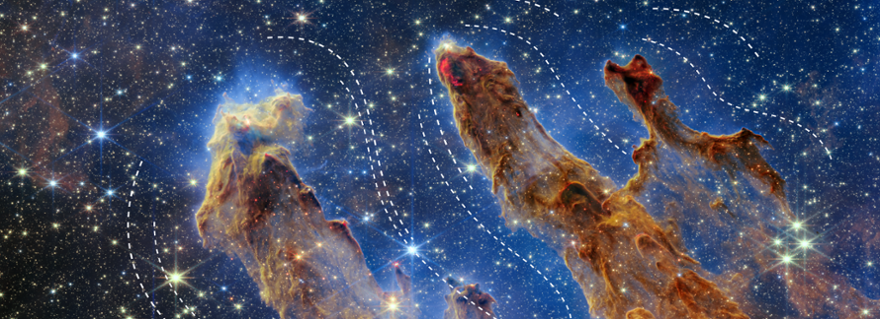
For over a year now, the James Webb Telescope has been sending stunning images that exceed astronomers' expectations. The photos are fascinating to see, but what exactly are we looking at? Assistant professor Melissa McClure explains.
McClure leads a research team that was one of the first in the world to work with data from the James Webb Telescope. She explains what can be seen in her four favourite images.
The earliest galaxies
'Around 20 years ago a group of astronomers focused the Hubble Telescope on a dark patch of space, without known stars or galaxies. After a total exposure time of 11 days, a photo emerged of almost 10,000 galaxies, including some of the oldest galaxies ever seen.'
Researchers wanted to repeat this with the James Webb Telescope, which can observe even older galaxies. 'Over billions of years, light from older stars shifted from UV and visible light to infrared light,' says McClure. 'If you want to see the oldest galaxies, you therefore need to capture infrared light with your telescope.' And James Webb can do this like no other. The result is a photo of an enormous number of old galaxies.
The galaxy in the photo (see above) comes from when the universe was only 350 million years old. 'This makes it the oldest galaxy we have ever observed. Photos like these mean we can study differences between old and younger galaxies. The next step is to look at whether we can determine which elements exactly are present in these old galaxies.'
Collision of galaxies
Ever wondered what a crash of intergalactic proportions looks like? Wonder no more. 'This photo is of a large elliptical galaxy that has collided at high speed with a smaller galaxy. The result is this amazing image.'
The collision took place when a small galaxy punched through the centre of the large galaxy in the photo. 'This produced a shock wave that blew material away from the centre, creating the outer ring at the galaxy's edge. Over time, the galaxy's rotation created large spiral arms that look like spokes, connecting the outer ring to the inner core, which is why the galaxy is called the Cartwheel Galaxy.'
In the centre of the galaxy is a massive amount of hot dust. In between are lighter patches, where gigantic clusters of young stars are found. The outermost ring, which is still expanding, is where stars are formed and supernovae (explosions of massive young stars) take place.
'This detailed image will help confirm astronomers' theories about the formation of this galaxy. The presence of so much dust in the outermost ring confirms that two galaxies collided here.'
Pillars of Creation
Images of these 'Pillars of Creation' were first captured by the Hubble Telescope back in 1995, but we have never seen them in such detail. How did these fascinating shapes form? 'The pillars are clouds full of molecular gas and dust. In this part of our galaxy, there are massive stars that produce strong stellar winds, which have blown away parts of these clouds. The top of the pillars contain denser parts of the cloud, which protected a column of material from the stellar wind.'
The James Webb Telescope can capture infrared light from stars inside the dust cloud. 'This has enabled us to look inside these clouds for the first time. We can see numerous new stars forming inside them, possibly with new planets around them. That's why we call these clouds the "Pillars of Creation".'
These young stars show up as small red spots. 'The light they emit appears red because the dust blocks the other light. That's also why sunsets are often red here on Earth.' Additionally there are larger bright red regions at the top of the pillars. 'These are caused by hot gas that is blown out by the youngest new stars. These stars are still hidden by the dust and otherwise invisible.'
Newborn protostars
A protostar is a very young star that is still gathering mass from the molecular cloud from which it formed. The protostar 'eats' mass from the molecular cloud at irregular intervals, McClure explains. 'If the protostar has eaten a big meal, it kind of burps, blowing out material. This photo is of a protostar with flows of these kinds of burps at the top and bottom, in the shape of an hourglass. After the burp, it quiets down for a while before another burp is produced.'
All these burps leave traces, which we can now see in detail for the first time. 'By studying more of these protostars, we can learn more about the timing of these burps and their effect on the surrounding molecular cloud.'
On the left of the image are several orange stars with six rays. This is due to the hexagonal shape of James Webb's mirrors. 'The star doesn't have a physical structure that produces the shape of the rays. It's a phenomenon caused by the mirrors. If you used another shape of mirror, you'd get another pattern. The Hubble Telescope's round mirrors produce four rays, for example.' The characteristics of the star do determine the size of the rays though. 'The brighter the star, the longer the rays.'
Text: Tom Janssen
Images: Fien Leeflang
Photos: NASA, ESA, CSA, STScI, Webb ERO Production Team






